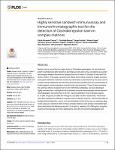Highly sensitive sandwich immunoassay and immunochromatographic test for the detection of Clostridial epsilon toxin in complex matrices
Féraudet-Tarisse, Cécile
Mazuet, Christelle
Pauillac, Serge
Krüger, Maren
Lacroux, Caroline
Popoff, Michel R.
Dorner, Brigitte
Andréoletti, Olivier
Plaisance, Marc
Volland, Hervé
Simon, Stéphanie
Epsilon toxin is one of the four major toxins of Clostridium perfringens. It is the third most potent clostridial toxin after botulinum and tetanus toxins and is thus considered as a potential biological weapon classified as category B by the Centers for Disease Control and Prevention (CDC). In the case of a bioterrorist attack, there will be a need for a rapid, sensitive and specific detection method to monitor food and water contamination by this toxin, and for a simple human diagnostic test. We have produced and characterized five monoclonal antibodies against common epitopes of epsilon toxin and prototoxin. Three of them neutralize the cytotoxic effects of epsilon toxin in vitro. With these antibodies, we have developed highly sensitive tests, overnight and 4-h sandwich enzyme immunoassays and an immunochromatographic test performed in 20 min, reaching detection limits of at least 5 pg/mL (0.15 pM), 30 pg/mL (0.9 pM) and 100 pg/mL (3.5 pM) in buffer, respectively. These tests were also evaluated for detection of epsilon toxin in different matrices: milk and tap water for biological threat detection, serum, stool and intestinal content for human or veterinary diagnostic purposes. Detection limits in these complex matrices were at least 5-fold better than those described in the literature (around 1 to 5 ng/mL), reaching 10 to 300 pg/mL using the enzyme immunoassay and 100 to 2000 pg/mL using the immunochromatographic test.
Dateien zu dieser Publikation
Keine Lizenzangabe

